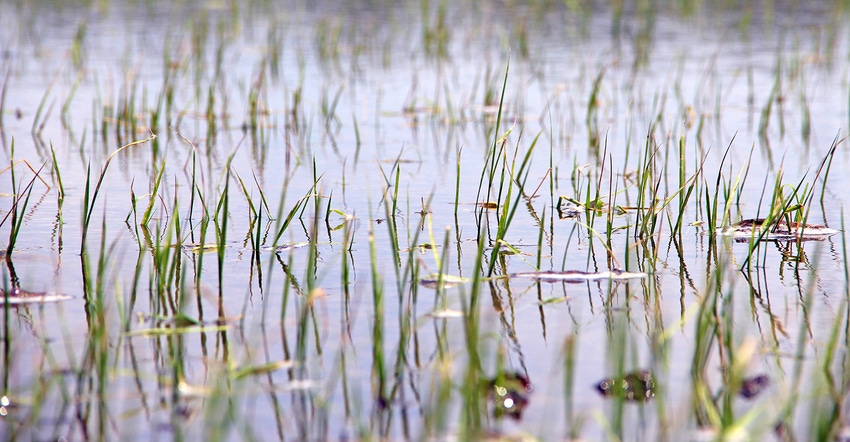
After a big rain across most of the Delta, another round on the way Thursday and Friday, here’s the first thing you need to do if you haven’t already: run an up-to-date DD50 on your fields (http://DD50.uaex.edu). Before you jump to conclusions on your field being too early or late to fertilize and flood, put the DD50 data behind that decision.
Now that we know where you stand let’s talk options. Much of the rice out there was planted early and needs to go to flood. However, you should wait until the date of ‘Final recommended time to apply preflood N if early N delayed’ found in the DD50 printout before you do anything drastic. Once you reach this date though, it’s time to make a move.
Repeating: if you have yet to reach this date, DO NOT make unnecessary or inefficient N applications, you still have time.
Now for those with fields that are out of time. If you have passed the Final Recommended Time, let’s talk. Have a flooded field right now from the rain? Roll up the gates and hold the water. Start spoonfeeding 100 lbs urea every 7 days – no more than 5 total applications – but evaluate closely after the 4th app to see if the 5th is even needed.
Do you think you can get dried up before the rain forecast on Thursday and Friday? Then you’ll want to go through the more usual scenarios below.
As a general reminder, here are the preferred management guidelines for preflood N:
In order of preference, based on yield response and N efficiency, here are options for applying preflood N based on field situations:
1. Field is dry: Apply NBPT-treated urea onto dry soil and establish the permanent flood in a timely manner to incorporate N below the soil surface. If you have any time to spare, it is always best to apply preflood N onto dry soil – applications onto muddy soil or into standing water are far less favorable and much less efficient methods of N fertilization.
2. Field is muddy: Apply NBPT-treated urea onto muddy soil and attempt to let the soil dry if you have time. If a significant rainfall event occurs (~0.5 in or more) to re-wet the field then begin flooding; otherwise let the soil dry before establishing the flood. If you’re applying N to mud we do not know exactly how much N will be lost, but increasing the N rate by ~ 20 lbs N would be wise to offset losses. This increase may or may not provide much benefit depending on your exact soil and weather conditions, but it’s less likely to hurt in this case. Watch the crop closely and apply extra N if a deficiency occurs.
3. Field has standing water: Get the water off the field if at all possible (if time allows). If you do not have time to get the water off and let the soil dry, then hold the water and “spoon-feed” N into the flood in small quantities every 5-7 days for 4-5 weeks is the best option – lean toward every 7 days. A small quantity means 45 lbs N per acre (100 lbs urea per acre). If you have a short time to internode elongation, maybe applying N for 3 weeks at 45, 60, and 60 lbs N per acre will be better but still apply a midseason shot of 45 lbs N per acre in addition. Do not, for any reason, apply the entire recommended preflood N rate in one application into standing water.
Preferred “worst-case” management: As rice reaches the end of the N application window according to the DD50 program, apply N treated with NBPT to muddy/wet soil and attempt to let the soil dry out underneath the applied N – if a significant rainfall occurs, start flooding. Realize that some N is lost in this case and be prepared to monitor the crop closely and apply additional N later if the rice looks like it needs it.
Fields unable to hold a flood (levees and gates unfinished or damaged): Apply a small amount of N and wait for the soil to dry or receive upcoming rainfall. If heavy rain is expected and movement is a concern, ammonium sulfate should be used for this application; otherwise, apply urea. If conditions are still not dry enough to flood the field in a week, subsequent N applications will be needed in the same manner until a flood can be established. At the point the flood can be established, apply any remaining N requirements to the dry soil and flood.
When preflood N is applied onto dry soil to rice at the 4- to 5-leaf stage and a flood is applied timely, plants take up at least 60% of the total N applied over the course of 3 weeks (10% week 1, 20% week 2, 30% week 3). In general the period from the optimum time to apply preflood N until internode elongation (IE) is about 3 weeks, but from the final recommended application time to IE is about 2 weeks. However, these timings are based on plant development when rice has received timely N fertilization and flooding – delaying these causes rice to develop more slowly. Keep in mind that we can only make up a small amount of yield with N applied at midseason.
Previous research has shown that N applied onto dry soil has the most yield benefit. Applying urea onto muddy soil can result in a 20% yield loss. However, applying ammonium sulfate or urea + NBPT onto muddy soil and letting the soil dry can reduce the yield loss to only 10%. In this research, N was applied just prior to permanent flood at the 4- to 5-leaf stage.
Past the 4- to 5-leaf stage, potential yield losses could become more dramatic. However, many factors influence how much flexibility we have in our N fertilization timing, including cultivar, length of maturity, native soil N, soil type, etc. If native soil N is high, then the effect is reduced. If it is a longer season cultivar then there is a greater window before midseason. In any case don’t let it get too late before applying N. Use of the DD50 Rice Management Program can help to time management decisions in these situations (http://DD50.uaex.edu).
About the Author(s)
You May Also Like






